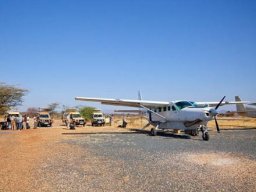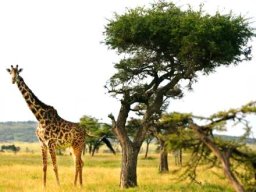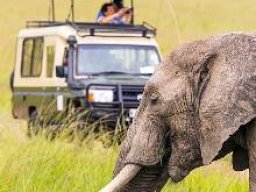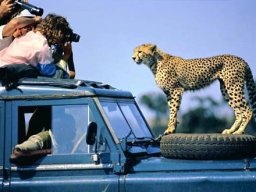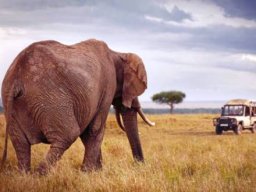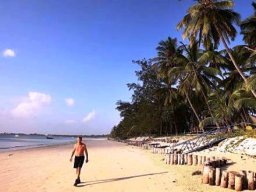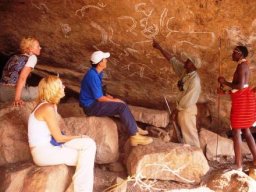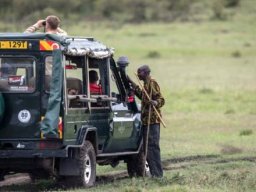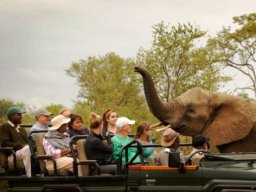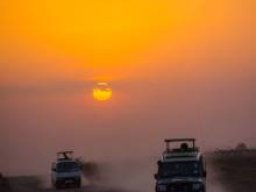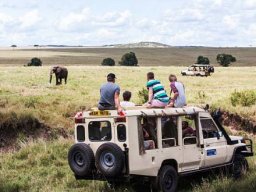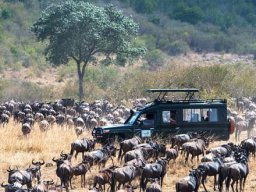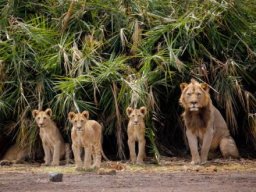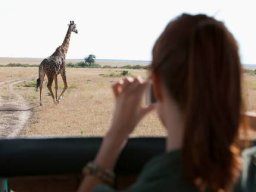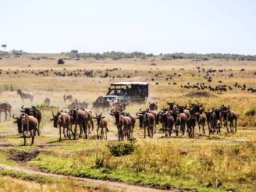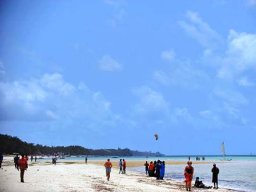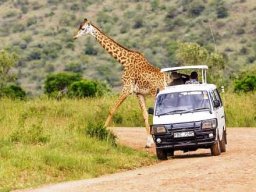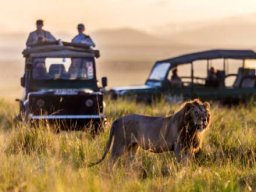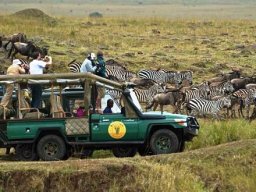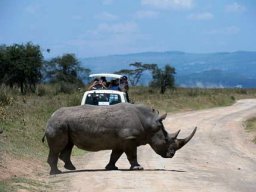Homejoy Safari Trips Photo Gallery - Tour Planning Consultant

A Kenya Safari tour gallery provides a captivating and immersive experience, allowing visitors to explore and appreciate diverse artistry, places, cultures, and historical moments while gaining a deeper understanding and connection with the world. :)
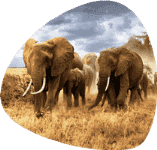 In today's digital era, a visually captivating website holds immense importance for businesses, particularly in the travel industry. When it comes to Kenya Safaris' websites, a satisfying tour gallery plays a crucial role. It goes beyond showcasing the beauty of different destinations; it entices potential travelers to embark on their own extraordinary tours and adventures. This study explores the necessity of having a satisfying tour gallery on a site and how it can elevate the overall user experience. By delving into the power of captivating visuals, the inspiration it provides, the trust and credibility it builds, the user experience it enhances, and the social media sharing capabilities it offers, Homejoy Safari Adventures uncover the key elements that make a tour gallery truly satisfying. Let's dive into the world of immersive travel experiences and discover why a satisfying tour gallery is a must-have for any travel website.
In today's digital era, a visually captivating website holds immense importance for businesses, particularly in the travel industry. When it comes to Kenya Safaris' websites, a satisfying tour gallery plays a crucial role. It goes beyond showcasing the beauty of different destinations; it entices potential travelers to embark on their own extraordinary tours and adventures. This study explores the necessity of having a satisfying tour gallery on a site and how it can elevate the overall user experience. By delving into the power of captivating visuals, the inspiration it provides, the trust and credibility it builds, the user experience it enhances, and the social media sharing capabilities it offers, Homejoy Safari Adventures uncover the key elements that make a tour gallery truly satisfying. Let's dive into the world of immersive travel experiences and discover why a satisfying tour gallery is a must-have for any travel website.
- Captivating Visuals: A satisfying tour gallery should be filled with high-quality, captivating visuals that transport viewers to different destinations. Images of stunning landscapes, vibrant cultures, and unique experiences can evoke emotions and create a desire to explore.
- Inspiration for Travel: A well-curated tour gallery can serve as a source of inspiration for travelers who consult Homejoy Safari Adventures. By showcasing a wide range of destinations, activities, and attractions, it can ignite wanderlust and encourage people to start planning their next trip. Including diverse photographs from various locations and perspectives can appeal to a broader audience and cater to different travel preferences.
- Building Trust and Credibility: A great tour gallery plays a vital role in building trust and credibility. When potential customers see visually appealing images of happy travelers experiencing memorable moments, they are more likely to trust the tour provider and feel confident in booking their Kenya Safaris & trips. Including testimonials or user-generated content alongside the images can further enhance trust and credibility.
- User Experience: An intuitive and user-friendly interface for the tour gallery is essential for a satisfying browsing experience. Implementing features such as easy navigation, quick-loading images, and responsive design ensures that visitors can explore the gallery seamlessly across different devices.
Having a satisfying tour gallery on Homejoy Safari Adventures website is crucial for attracting and engaging potential travelers planning to visit Kenya. By incorporating captivating visuals, inspiring travel ideas, building trust, enhancing user experience, and enabling social media sharing, a tour gallery can significantly contribute to the success of a travel website. So, if you're in the travel industry, make sure to invest in creating an impressive Kenya Safari gallery that leaves a lasting impression on your audience.
Fun Things to Consider as You Plan for a Safari Tour in Kenya
The Local Culture
A Kenya safari tour may include visits to local villages or tribes to learn about their traditions and customs. This is especially fun and very refreshing.
Local Guides
Engaging local guides who have a deep knowledge of the ground, wildlife, and environment. They may also share stories about the destination's history.
Fun Activities
Ensure that your Kenya safari explores additional activities such as hot air balloon rides, walking safaris, or bush walks for a more immersive experience.
Language
Most safari tours are conducted in English, but if you are not fluent in English, it's a good idea to check if there are guides who speak your native language.
Considering a Photographic Kenyan Safari? We Can Help You Plan
 A photographic safari is a type of wildlife safari tour that focuses on capturing high-quality photographs of animals, landscapes, and natural environments. It involves traveling to various wildlife-rich regions and national parks, typically in Africa but also in other parts of the world, with the primary goal of photographing wildlife in their natural habitats. Photographic safaris are designed to provide photographers with optimal opportunities to capture stunning images of wildlife. These safaris are led by professional wildlife photographers or experienced guides who are knowledgeable about animal behavior and know the best locations and times for photography.
A photographic safari is a type of wildlife safari tour that focuses on capturing high-quality photographs of animals, landscapes, and natural environments. It involves traveling to various wildlife-rich regions and national parks, typically in Africa but also in other parts of the world, with the primary goal of photographing wildlife in their natural habitats. Photographic safaris are designed to provide photographers with optimal opportunities to capture stunning images of wildlife. These safaris are led by professional wildlife photographers or experienced guides who are knowledgeable about animal behavior and know the best locations and times for photography.
During a photographic safari, participants embark on game drives in specially designed Kenya safari vehicles that allow for unobstructed views and easy maneuverability. These vehicles are often equipped with elevated roofs or open sides, ensuring photographers have clear sightlines to capture images without barriers. Photographic Kenya safaris typically offer ample time for observation and photography, allowing photographers to carefully compose their shots and capture wildlife behavior. Participants can expect to encounter a wide range of wildlife, including iconic animals like elephants, lions, giraffes, zebras, rhinos, and many more.
In addition to game drives, some photographic safaris may include other activities such as walking safaris, where photographers can explore the terrain on foot accompanied by armed guides, or boat safaris, which provide unique perspectives and opportunities for photographing aquatic wildlife. Homejoy Safari Adventures helps to arrange for photographic safaris that cater to photographers of all skill levels, from beginners to professionals. They provide a supportive and educational environment, often offering workshops, tutorials, and critique sessions led by experienced photographers. These sessions aim to enhance participants' photography skills and help them capture memorable and impactful images.
Adventurous Photographic Safaris in Kenya- Capturing The Moment
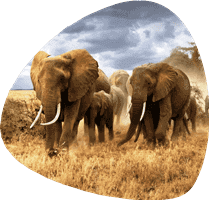 Photographic Kenya safaris offer a truly unforgettable experience for nature enthusiasts and wildlife photographers alike. Renowned for its stunning landscapes and diverse wildlife, Kenya provides an ideal setting for capturing breathtaking images of some of Africa's most iconic animals in their natural habitats.
Photographic Kenya safaris offer a truly unforgettable experience for nature enthusiasts and wildlife photographers alike. Renowned for its stunning landscapes and diverse wildlife, Kenya provides an ideal setting for capturing breathtaking images of some of Africa's most iconic animals in their natural habitats.
✓ One of the most famous destinations for photographic safaris in Kenya is the Maasai Mara National Reserve.
Located in the southwestern part of the country, the Maasai Mara is home to the Great Migration, one of the most remarkable wildlife spectacles on the planet. Each year, millions of wildebeests, zebras, and other herbivores migrate across the plains in search of fresh grazing. Photographers have the opportunity to witness this awe-inspiring event and capture remarkable images of the animals crossing crocodile-infested rivers or grazing on the vast savannah.
In addition to the Great Migration, the Maasai Mara offers abundant wildlife throughout the year. From majestic lions and graceful cheetahs to herds of elephants and giraffes, the reserve provides ample opportunities to photograph a wide range of wildlife in action. Experienced safari guides who possess in-depth knowledge of animal behavior and the best locations for photography can enhance the overall experience, helping photographers to capture the perfect shots.
✓ Another popular destination for photographic safaris is Amboseli National Park.
Situated at the base of Mount Kilimanjaro, this park boasts breathtaking scenery, including open plains, marshes, and acacia woodlands. Amboseli is particularly renowned for its large herds of elephants, often photographed against the stunning backdrop of Africa's highest peak. The park also offers opportunities to photograph other wildlife, such as lions, zebras, giraffes, and various bird species.
✓ Other notable photographic safari destinations in Kenya include Samburu National Reserve, Tsavo East and West National Parks, and Lake Nakuru National Park.
Each of these locations presents unique photographic opportunities, ranging from rare wildlife species to stunning landscapes.
When embarking on a photographic safari in Kenya, it is essential to come prepared with the right equipment. Telephoto lenses are particularly useful for capturing close-up shots of wildlife, while wide-angle lenses can capture expansive landscapes. It's also advisable to bring extra batteries, memory cards, and a sturdy tripod to ensure that you can make the most of your time in the field.
Furthermore, working with experienced and knowledgeable guides, Homejoy Safari Adventures, or joining specialized photography-focused safari tours can significantly enhance your photographic safari experience. These guides are familiar with animal behavior, know the best times and locations for photography, and can offer valuable insights and tips to help you capture extraordinary images.
Kenya's photographic safaris not only offer incredible wildlife encounters but also provide an opportunity to immerse yourself in the country's rich cultural heritage. Many lodges and camps in these safari destinations offer a blend of comfort and authenticity, allowing you to experience the warm hospitality of local communities while enjoying the beauty of the wilderness.
Photographic Kenya safaris offer a most remarkable experience and a lifetime opportunity to capture stunning images of Africa's wildlife and landscapes. With its diverse wildlife, breathtaking scenery, and experienced guides, Kenya remains a premier destination for photographers seeking to capture the magic of the African wilderness through their lenses.
How to Plan For a Momentous Photographic Safari in Kenya
Planning a momentous photographic safari in Kenya requires careful consideration and preparation to ensure you have the best possible experience capturing extraordinary images. Here are some steps to help you plan your Kenya safari:
- Determine your goals: Define what you hope to achieve from your photographic safari. Are you looking to capture specific wildlife, landscapes, or moments? Identifying your goals will help you choose the right destinations and make the most of your time in Kenya.
- Research destinations: Kenya offers a wide range of national parks and reserves, each with its unique features and wildlife. We actually can help you with researching different destinations such as the Maasai Mara, Amboseli, Samburu, and Tsavo to determine which ones align with your photographic goals. Consider factors such as wildlife abundance, diversity, and specific species you want to photograph.
- Choose the right time: Wildlife behavior and seasonal changes can greatly impact photographic opportunities. You need to find out the best time to visit your chosen destinations based on factors like the Great Migration in the Maasai Mara or the dry season in Amboseli for clear views of Mount Kilimanjaro. Also, consider the weather conditions and how they might affect your photography.
- Select a reputable tour operator or consultant: Working with a trusted tour consultant, operator, or a safari company that understands photographic safaris is highly recommended. Homejoy Safari Adventures are able to help you get experienced guides who have in-depth knowledge of wildlife behavior and the best photography techniques. They can help you navigate the parks, find the best spots, and offer insights and guidance for capturing stunning images.
- Plan your itinerary: Once you have chosen your destinations and tour operator, work with them to create a well-rounded itinerary. Consider the number of days you have available, the time you want to spend in each location, and the activities you want to include. Ensure you have ample time for wildlife viewing, photography sessions, and potential game drives during golden hours (early morning and late afternoon).
- Pack the right gear: Take stock of your photography equipment and ensure you have the necessary gear for capturing wildlife and landscapes. This typically includes a DSLR or mirrorless camera body, a variety of lenses (telephoto, wide-angle), extra batteries, memory cards, a sturdy tripod, and lens cleaning equipment. Pack your gear securely and consider bringing a suitable camera bag or backpack for protection during travel and game drives.
- Learn about wildlife behavior: Understanding animal behavior can significantly improve your chances of capturing impactful images. Familiarize yourself with the behavior patterns, movements, and habits of the wildlife you wish to photograph. This knowledge will help you anticipate their actions and be ready to capture those special moments.
- Be patient and flexible: Wildlife photography requires patience and flexibility. Animals may not always appear on cue, and weather conditions can change. Embrace the unexpected, be prepared to adapt your plans, and take advantage of any opportunities that arise. Remember that capturing that perfect shot may require time and persistence.
- Respect wildlife and the environment: As a responsible photographer, it is essential to prioritize the well-being of wildlife and the environment. Follow ethical guidelines and regulations provided by your tour operator or park authorities. Maintain a respectful distance from the animals, avoid interfering with their natural behavior, and never endanger yourself or the animals for a photograph.
- Immerse yourself in the experience: Finally, remember to immerse yourself fully in the moment. Take breaks from behind the lens to appreciate the beauty of your surroundings, observe wildlife interactions, and absorb the unique atmosphere of the Kenyan wilderness. The experience of a photographic safari goes beyond capturing images—it's about creating lasting memories.
